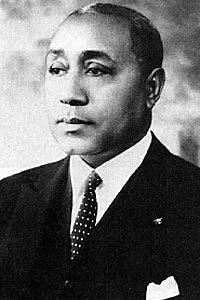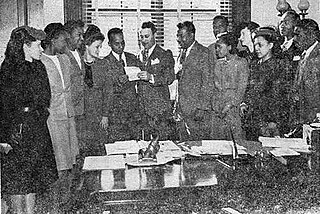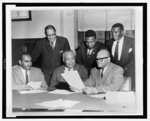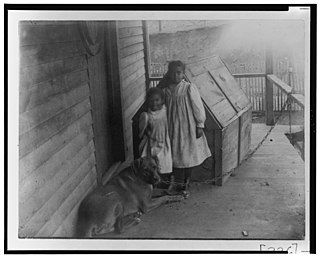Related Research Articles

The Southern Christian Leadership Conference (SCLC) is an African-American civil rights organization based in Atlanta, Georgia. SCLC is closely associated with its first president, Martin Luther King Jr., who had a large role in the American civil rights movement.

Walter Francis White was an American civil rights activist who led the National Association for the Advancement of Colored People (NAACP) for a quarter of a century, from 1929 until 1955. He directed a broad program of legal challenges to racial segregation and disfranchisement. He was also a journalist, novelist, and essayist.
The civil rights movement (1896–1954) was a long, primarily nonviolent action to bring full civil rights and equality under the law to all Americans. The era has had a lasting impact on American society – in its tactics, the increased social and legal acceptance of civil rights, and in its exposure of the prevalence and cost of racism.

John Wesley Dobbs was an African-American civic and political leader in Atlanta, Georgia. He was often referred to as the unofficial "mayor" of Auburn Avenue, the spine of the black community in the city.

The Southern Negro Youth Congress was an American organization established in 1937 at a conference in Richmond, Virginia. It was established as a left-wing civil rights organization, arising from the National Negro Congress (NNC) and the leftist student movement of the 1930s. The SNYC aimed to empower black people in the Southern region to fight for their rights and envisioned interracial working-class coalitions as the way to dismantle the southern caste system. The NNC itself had been created in 1936 to address the economic and discriminatory challenges faced by African Americans, especially in New Deal programs.

Disfranchisement after the Reconstruction era in the United States, especially in the Southern United States, was based on a series of laws, new constitutions, and practices in the South that were deliberately used to prevent black citizens from registering to vote and voting. These measures were enacted by the former Confederate states at the turn of the 20th century. Efforts were also made in Maryland, Kentucky, and Oklahoma. Their actions were designed to thwart the objective of the Fifteenth Amendment to the United States Constitution, ratified in 1870, which prohibited states from depriving voters of their voting rights based on race. The laws were frequently written in ways to be ostensibly non-racial on paper, but were implemented in ways that selectively suppressed black voters apart from other voters.

Adrienne Elizabeth McNeil Herndon (1869-1910) was an actress, professor, and activist in Atlanta, Georgia. While admittedly an African American to friends and colleagues, she performed with the stage name Anne Du Bignon. She was one of the first African American faculty at Atlanta University, where she was a peer of W. E. B. Du Bois. She was married to prominent businessman Alonzo Herndon.
The civil rights movement (1865–1896) aimed to eliminate racial discrimination against African Americans, improve their educational and employment opportunities, and establish their electoral power, just after the abolition of slavery in the United States. The period from 1865 to 1895 saw a tremendous change in the fortunes of the Black community following the elimination of slavery in the South.

The Lily-White Movement was an anti-black political movement within the Republican Party in the United States in the late 19th and early 20th centuries. It was a response to the political and socioeconomic gains made by African-Americans following the Civil War and the Thirteenth Amendment to the Constitution, which eliminated slavery and involuntary servitude.
The Atlanta Student Movement was formed in February 1960 in Atlanta by students of the campuses Atlanta University Center (AUC). It was led by the Committee on the Appeal for Human Rights (COAHR) and was part of the Civil Rights Movement.

Austen Thomas Walden, also known as A. T. Walden was an American lawyer and civil rights leader. In 1964, he was appointed by Ivan Allen Jr. as a municipal judge, the first black judge to be appointed in the state of Georgia since Reconstruction.

African-American Georgians are residents of the U.S. state of Georgia who are of African American ancestry. As of the 2010 U.S. Census, African Americans were 31.2% of the state's population. Georgia has the second largest African American population in the United States following Texas. Georgia also has a gullah community. African slaves were brought to Georgia during the slave trade.

Henry Lincoln Johnson was an American attorney and politician from the state of Georgia. He is best remembered as one of the most prominent African-American Republicans of the first two decades of the 20th century and as a leader of the dominant black-and-tan faction of the Republican Party of Georgia. He was appointed by President William Howard Taft as Recorder of Deeds for the District of Columbia, at the time regarded as the premier political patronage position reserved for black Americans, and one of four appointees known as Taft's "Black Cabinet".
The Afro-American Sentinel was a newspaper in Omaha, Nebraska. It was established in 1893, and ran issues until 1899. The newspaper published articles relevant to Nebraska's black community. It was strongly in favor of self-defense against lynching, and issued reports about the extent of discrimination within the city.

The Colored Radical was an African American newspaper in Kansas. It was the first black newspaper in the state and was published in Lawrence and Leavenworth for just under three months in 1876. The paper supported the Kansas Republican Party during the that year's elections, argued against racial segregation, and reported on lynchings like the Hamburg massacre in Hamburg, South Carolina. Following the conclusion of the elections, the paper dissolved, and only five of its fourteen issues are extant.
Henry O. Mayfield was an American miner and social activist. Mayfield was one of the Black miners who played an active role in forming the new Congress of Industrial Organizations (CIO) between 1935 and 1955; he also had a leadership role in the SNYC. He served the United States as a soldier in World War II; afterwards, he and other veterans worked to support voting rights. He worked with other Black leaders in the Congress of Industrial Organizations to advocate for the rights of laborers, especially in the southern United States. Mayfield was watched by the FBI and was arrested for his work in the Communist Party and advocacy for civil rights. Mayfield served as chairman of the board for Freedomways Associates, the publishing company for the cultural magazine Freedomways, up until his death.
Q. V. Williamson was an American businessman and politician. Williamson was the first black person to serve on the Atlanta Board of Aldermen since Reconstruction, elected in 1965 and taking office in 1966. He was also involved in the establishment of the Collier Heights neighborhood in Atlanta.
John H. Calhoun Jr. was an American civil rights leader and politician who served on the Atlanta City Council from 1974 to 1978.
RobertChilds "Big Duck" Mallard was an African American traveling casket salesman and landowner, who was shot and lynched by a group of about 20 members of the Ku Klux Klan in Lyons, Toombs County, Georgia. The people charged with his murder were acquitted by an all-white jury.
The National Independent Political League (NIPL) was an American political organization that sought racial and social justice in the early 20th century. Considered a militant group, NIPL was founded by William Monroe Trotter in 1908 as the NationalNegro American Political League and operated until around 1920 as the National Independent Equal Rights League. In contrast to its more successful contemporary, the NAACP, NIPL was led and funded by African Americans. Historian Mark Schneider notes that NIPL "foreshadowed the militant organizations of the 1950s and 1960s that bypassed the NAACP."
References
- ↑ "John Calhoun, 88; A Longtime Fighter For Rights in South". The New York Times. May 10, 1988. p. 26.
- ↑ "Atlanta Negro Voters League". New Georgia Encyclopedia. Retrieved October 28, 2023.
- ↑ Walker, Jack (1963). "Negro Voting in Atlanta: 1953–1961". Phylon. 24 (4): 379–387. doi:10.2307/273379. ISSN 0031-8906. JSTOR 273379.
- ↑ "The Historical Dynamics of Black Political Organization in the Urban South" . Retrieved October 28, 2023– via ProQuest.
- ↑ Bayor, Ronald H. (1996). Race and the Shaping of Twentieth-Century Atlanta. Univ of North Carolina Press. pp. 25–26. ISBN 978-0-8078-4898-2.
- ↑ "2 Whites Indicted in Georgia Killing – Early Trial slate in Ambush of Negro – McGill, Editor, Closeted With Jurors". The New York Times . December 11, 1948. p. 32.
- ↑ Alexander, Lee (January 1, 1979). "Expanding Sources for Black Research at Atlanta University". Georgia Archive. 7 (1). ISSN 0095-6201.
- ↑ "Atlanta Negro Voters League, 1959". credo.library.umass.edu. Retrieved October 28, 2023.
- ↑ Jennings, M. Kent; Zeiger, Harmon (October 30, 1966). "Class, Party, and Race in Four Types of Elections: The Case of Atlanta". University of Chicago Press . 28 (2): 391–407. doi:10.2307/2127554. JSTOR 2127554. S2CID 56139164.
- ↑ Hein, Virginia H. (1972). "The Image of 'A City Too Busy to Hate': Atlanta in the 1960's". Phylon. 33 (3): 205–221. doi:10.2307/273521. ISSN 0031-8906. JSTOR 273521.
- ↑ Drake, Akira (May 2014). "THE POLITICS OF ATLANTA'S PUBLIC HOUSING: RACE, PLANNING, AND INCLUSION, 1936-1975".